This guide will help you understand how solar panels work, how they function as part of a solar power system and which panels would best suit your needs.The
best-known part of a solar power system is the Solar Panels.
Solar energy is probably the most popular renewable energy in the world today.
The solar power industry is ever-growing, and as always, new technology is being produced all the time.
Here’s the breakdown:
- Fundamentals
- How Do Solar Panels Work?
- Monocrystalline vs Polycrystalline
- Solar Panel Sizing
- Is Your Roof Suitable?
- Solar Panel Costs
- Solar Panel Brands
- How the Panel Fits in A System
Chapter 1
Solar Panels: Fundamentals
Let’s start from the top
- Photovoltaic
- Array
- String
- Parallel
- MPPT
Are You A Beginner?
As always, we’ll start off with the fundamentals.
If you’re not new to our guides and know the jargon used in the solar industry, you may want to scroll past this section.
Photovoltaic

The word ‘photovoltaic’ is made up of two words. The Greek word ‘phōs’ means ‘light’ and ‘volt’, the electromotive force unit.
The definition of photovoltaic means to produce energy from the sun.
Array

String

Parallel

MPPT

If you have any questions that have not been covered in this article, you can always contact us.
CHAPTER 2
How Do Solar Panels Work?
Understanding the science
I don’t want to bore you with the details so, I’ll give you a basic rundown on how they work below.
If this information is too much to take in don’t worry, there are tools like EnergyBee that can break everything down for you, it’s completely free.
Moving Electrons
Photons from sunlight cause free electrons to move through a circuit by forcing the electrons from their bonds in the N-Type layer to fill voids in the P-Type layer, generating electricity.
To learn more about the inner workings of solar panels, watch this video:
If you’d like to read in-depth about solar panels, you can do so here.
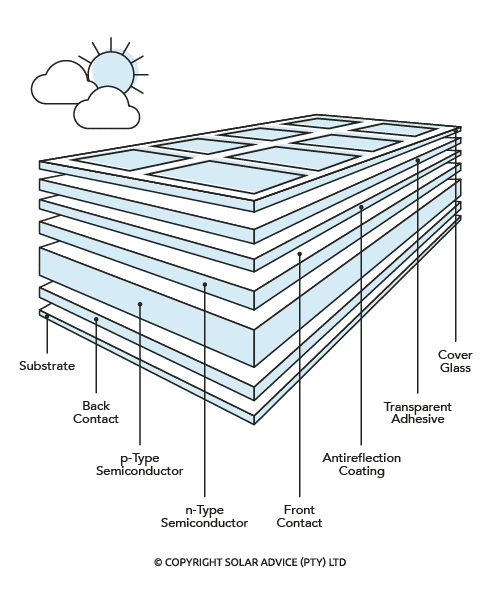
What are Solar Panels Made from?
Solar panels are made of different components.
But, the heart of the solar panel is the solar cell. Solar cells are made from an abundant resource; silicon.
An intricate manufacturing process produces either Monocrystalline or Polycrystalline solar cells.
Monocrystalline cells are made up of solid, uniformed silicon slices, whereas polycrystalline cells are made of small silicon pieces fused together.
CHAPTER 3
Monocrystalline vs Polycrystalline Solar Panels
What are the differences
That’s why it’s good to learn about the different cells available.
Each has its place in the solar market, but the application will dictate which product is best for you.
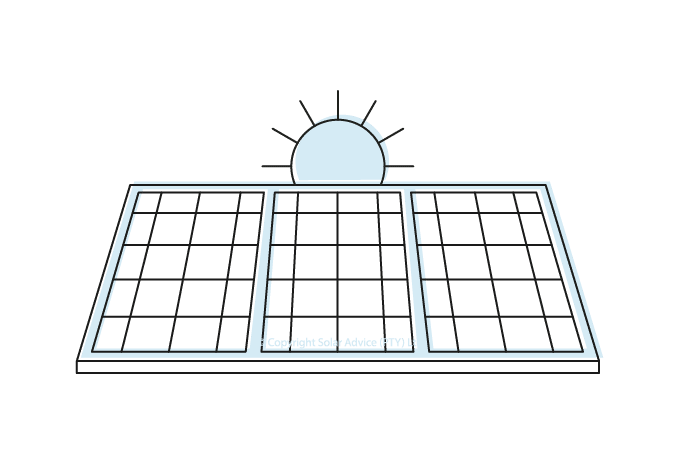
Monocrystalline Solar Panels
The Monocrystalline panel is cut from a single crystal structure. Out of the different varieties, they are the oldest technology. The solar cells have a uniform flat colour.
Note: They are more expensive per watt but are more efficient; this means you can install fewer high-efficiency panels.
Best used:
Residential and Commercial projects
If there is limited space available

Pros
- Most efficient
- More heat resistant
- Durable
Cons
- Most expensive per watt

Polycrystalline Solar Panels
The polycrystalline panel is a newer technology. Due to the cells being made up of fused together pieces of silicon, they have a less uniform appearance.
They tend to be the most affordable with the lowest price per watt; although they put out a little less power, they are becoming more efficient.
Note: Their production is better for the environment as they require fewer resources to make, making them the ‘greener’ option.
Best used:
For Grid-Tied systems
Best Solar Panel price
Looking for the “greenest” option
Pros
- Most affordable
- Long-lasting
- Require less silicon
- Durable
Cons
- Least efficient
CHAPTER 4
Solar Panels Sizing
How many panels can you fit?
If you have little space for panels, you will need a higher power rating panel, like a 400W panel.
But, if you have a lot of space, then you can look at having more lower power rating panels.
However, it’s worth a mention that should you wish to add more solar panels at a later stage, the larger panels will be the better choice due to availability, later on.

New Technology

Solar Panel sizes are changing all the time for bigger and better panels. For instance, the panels we now sell are vastly bigger in rating than the panels we were selling between 2 and 3 years ago.
Naturally, with the betterment of solar panel technology, obsolete tech has now been abandoned. Therefore, making it near impossible to find those 180W panels you bought back in 2018.
Adding To An Old Array

Voltage plays a huge role in being able to add to your array. Absolutely any panel with more than a 5V difference will simply not work and will cause you a lot of frustration. Additionally, it is important to say that your adding larger panels to an array that contains smaller panels will see your new panels performing as well as the old panels.
However, if you have an inverter with multiple MPPTs and have an MPPT available, you can add whatever panel you’d like.
For First Time Buyers

In conclusion, when choosing panels for a new setup, our advice would be to ensure you choose the biggest size panel that your inverter will allow. Moreover, if you want to maximise your array later, do it within 6-12 months after buying your current setup. Because there are no guarantees that the size panel you want will be available.

Want to know how to size an array?
We have a array sizing guide that will further explain how to size an array based on your needs and your inverter’s parameters.
How to Size a Solar Array GuideCHAPTER 5
Solar Panels: Is Your Roof Suitable?
Let’s see

Simple or Complex Roof
The shape and design of a complex roof will leave you at a slight disadvantage. Though it is possible to install solar panels on complex roofs, it is going to cost more.
The solar panels need to be facing the same direction, installed perfectly to harvest as much of the sun’s rays as possible. A solar panel installation on a roof like the complex roof will require elaborate mounting kits, which will take longer to install, costing you more for labour and materials.
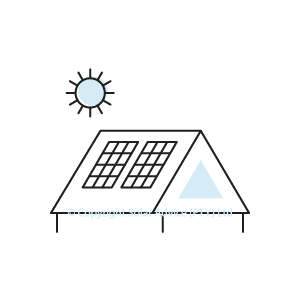
Solar Panels: Roof Direction
To have a productive array, your solar panels will need to face the sun all day.
If your roof is not directly sun-facing, you can still benefit from solar panels. For these homes, I suggest having 2 separate arrays. One to harvest solar in the mornings and one to harvest solar in the afternoons.
What ever the issue, a solar installer will be able to give you some suggestions.

Solar Panels: Roof Material
In South Africa, most houses have tiled, pitched roofs. However, there are a few other types, like metal or thatched roofs. Tiled and corrugated roofs are perfect for installing solar panels, but thatched roofs are highly flammable and it is seriously dangerous to have solar panels installed.
We have many flat roofs here in South Africa, too, which can support solar panels. However, you will need specialist structures to install your panels on to be angled perfectly.
The Amount Of Shade Covering The Roof

Solar panels produce power by using the sun’s rays, so any shading will not be helpful at all. You will need to ensure that your roof has little to no shading from chimneys, trees and other buildings.
Trees can be trimmed back, and optimisers can be used to help in minor shading situations.
If there’s a way you can get around the shading problem, your solar installer will be able to help you come up with a solution.
Solar Panels: Age And Support

It might not be easy to hear, but your roof has a time limit, and with this time limit comes a level of support it can provide to the solar array.
Once again, you want to contact an expert in this area and take a more in-depth look at your roof’s condition.
There is a multitude of variables that go into installing panels. The good news is that there’s usually a way around most common problems.
CHAPTER 6
Solar Panels Cost
Explained

Solar Panel Prices
Solar Panel prices depend on brand and size.
Prices range between around R2500 for a 345W Monocrystalline Solar Panel and R4500 for a 540W Monocrystalline Solar Panel.
Solar Panel Installation Price
Solar panel installation costs vary from installer to installer.
However, you will usually pay a base cost for a Solar Power Kit installation which will include the hanging and wiring of your inverter and battery and the connection to your distribution board.
Then will be a per panel installation price.
If you need to install 12 solar panels, your installation cost will be higher than that of someone who only needs 6.
For a 6 panel installation, you can expect to pay upwards of R12,000.
CHAPTER 7
Solar Panel Brands
Our 2 favourites

Canadian Solar boasts a reputation for being among the world’s three largest solar panel brands in terms of size.
Their employee base has grown to more than 9700 staff members, and the brand operates on no less than six continents.
Top features:
- High-quality panels
- Production lines in South Africa
- Affordable Solar Panel price
- Global leaders in Solar Energy
- Great support
- Offer guarantees
- Long-lasting Panels

Based in Shanghai, JA Solar has been operational since 2005. Over the years, the company has gained a strong reputation for producing some of the highest performance cells and modules, and its international client base is growing at a rapid pace.
Top features:
- High-performance panels
- Innovative
- Affordable Panels
- Global leaders in Solar Energy
- Trusted brand
- Offer guarantees
- Long-lasting Panels
CHAPTER 8
How The Panel Fits In With A System
The puzzle pieces
You will also need the following:
Solar Inverter
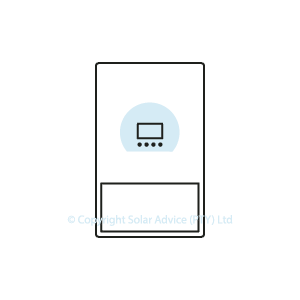
The inverter plays a vital role within every solar system, converting the DC power to AC power.
Your panels produce DC power, and your batteries store DC power. You need the inverter to be able to use the generated and stored energy in your home.
Most plug-and-play inverters come with an MPPT installed inside the battery, making installation quick and easy.
Solar Batteries

Batteries are an optional component. You are essentially using power on demand; this means they only use solar energy when the sun is shining.
Due to our ongoing load shedding dilemma in South Africa, most clients buy batteries for their systems.
If you spend most of your day at work and use most energy at night, batteries just make sense. Take a look at our Complete Guide on Solar Batteries to understand what you might need.
Learn More
If you like to learn more about the different types of Solar Inverters and Batteries, take a look at the two videos below:
CHAPTER 9
FAQ
What you want to know
What size solar panel do I need?
There are numerous sizes of solar panels available. However, due to solar panel manufacturers producing larger panels, it would be best to buy 450W panels and up.
How many solar panels do I need?
The average household uses between six and fourteen 455W solar panels and up to around twenty-three panels for bigger homes. But, it depends on the space you have available, your electricity usage and the parameters of your inverter.[endfaqmicro]
How to calculate solar system size?
Find your average monthly usage in kW, divide that by 30 (days in the month) then divide that number by 5.5 (average peak sun hours per day in South Africa). This will give you the size of the array that you’ll need. Then you take your array size and divide that by the watt rating of a panel like a 455W panel to find out how many solar panels you’ll need.
We have a complete guide that digs into how to size a solar system.
EG:
900kWh average monthly usage / 30 days = 30kWh daily usage
30kWh / 5.5 average maximum production hours = 5454.54kWh array size needed
5454.54kWh / 455W solar panel rating = 11.988 solar panels needed so round it up to 12.[endfaqmicro]
How long do solar panels last?
Solar Panels can last 20 years and sometimes even up to 30 years. Ensuring that your system is in good health, you should see your solar equipment running smoothly well into the future.
How many panels in a 5kw solar system?
The number of panels you will need within a 5kW system is entirely dependent on the parameters of the inverter. You will first need to check what the maximum PV array input is and secondly, check the voltage ranges of the inverter. You do not want to exceed either of those 2 parameters.
Which direction should solar panels face in South Africa?
Your solar panels should be in the sun all day to be able to produce solar power. So north-facing is best in South Africa. However, if your roof is not north-facing, you can still produce solar power by installing two arrays, one on the east and one on the west-facing roof. That way your east-facing array will produce solar power in the morning and your west-facing roof will produce solar power in the afternoon. To do this, you will need a high voltage inverter with 2 MPPTs or 1 MPPT with a combiner box.
Take at look at all the components under our product listings, here you will understand all the various parts required.
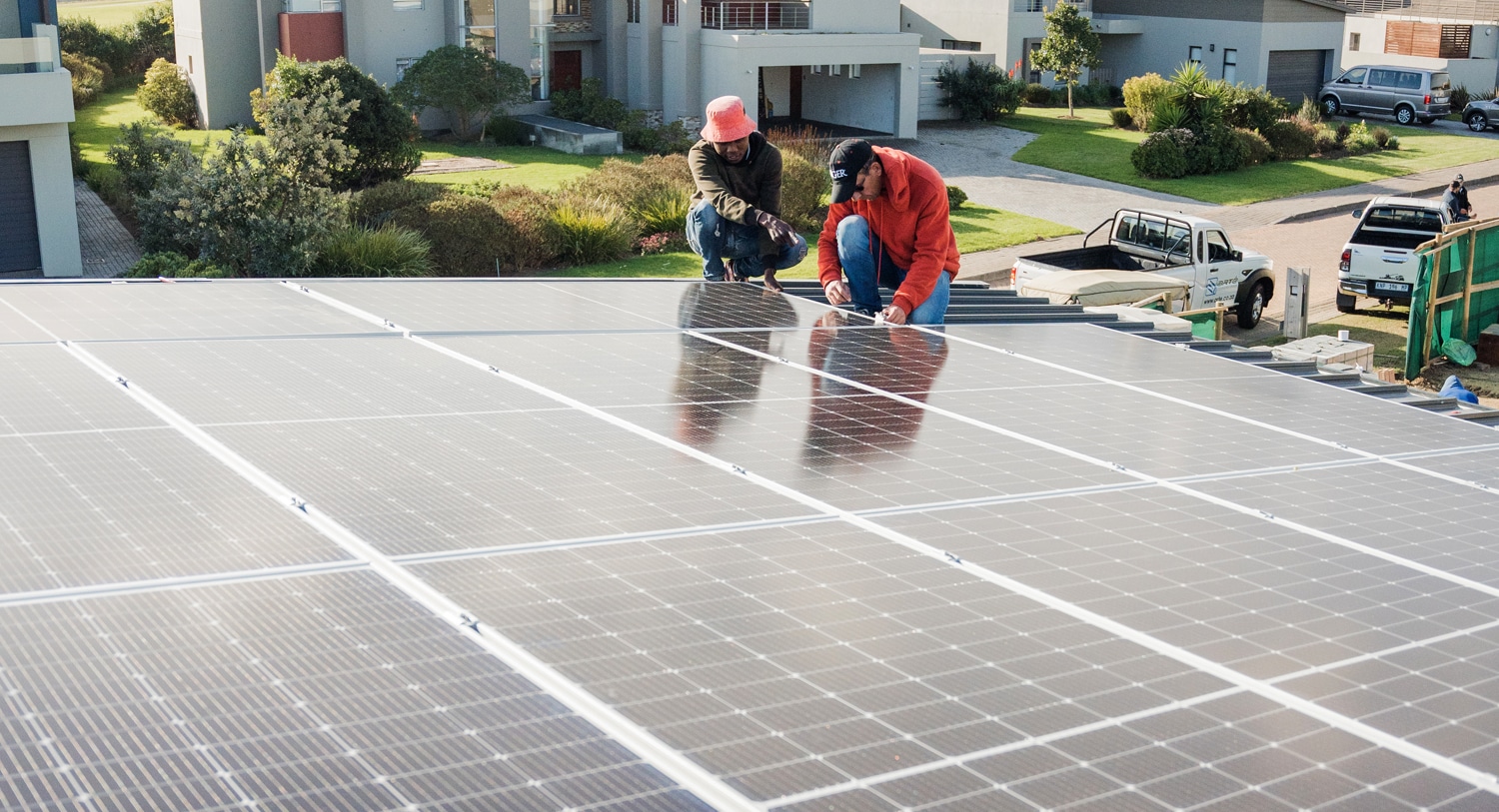
I use at present 480 kilowat a month mainly at night,how many panels i need and size of back up battery and can i use at night a heater of 1,5 kilowat for 14 hours and what is total cost of the package?what happens in winter when here westcoast sometimes overcloud for 2 weeks?thankyou in advance also.
Hi,
480kw / 30 days = 16kw p/day
16kw / 5.5 peak hours =2.91kw solar array
2.91kw / 330w = 8.7 / 9 x 330w panels.
The storage would be according to what % of that energy is required to be used at night. So if 50% is night usage, then 8kw back up is required.
I am using 430kwh per month. I have gas stove usage 99% of the time, my geyser is retro fitted with the evt tubes.
I am interested in the hybrid grid tie system.
what system will be Ideal form me? At night I am mainly running fridge and freezer(24 hr run), TV and 1 or two two lights,rest of the lights go on only on demand.
kindly help.
Hi, thanks for sharing your monthly usage. The fact you have a solar geyser and you’re also on gas makes solar perfect for your situation.
A Hybrid system will be perfect for you, here’s how we work out the size:
430kwh * 30 days (1 month) / 5.5 (average sunlight hours a year) = 2.6kw
So the max output is 2.6kwh, BUT to be safe we advise taking an Inverter that can handle more, so you can go for a 3.6kw or 4kw kit (we highly recommend the Goodwe version), so any of the kits here except the 2kw option: https://solar.co.za/shop/solar-power/solar-power-kit/hybrid-solar-power-kits/
Then you’ll need to consider your backup options, you can go for a 1.96kwh option and add later, or increase it to whatever you want, depending on how many hours you need in the evening.
Average is around 4 hours plus appliances like your fridge and freezer. You will also have the grid to fall back on if some evenings you exceed this.
Hope that helps, feel free to ask more questions, we love helping!
Good day! I am looking to bring my 980 units monthly down to under 600 units to stay in a certain tariff, i have 60A 3 phase supply (also solar geyser and gas hob)- and thought of getting a 3 phase 8kw pv solar inverter ( 30x 330W panels)for saving only (no battery backup. i have a few questions you might help me with, 1. what would the application to the city cost? 2. Will it be worth while spending R80 000 to do this? 3. i have a prepaid meter – would i need some smart meter or something. I really would like to Spend R900 instead of R2000 a month so i can pay back the system over 80 months (6 years) – does it seem possible? Thanks so much
Hi, we will reply back via email as soon as we can get to your request.
Visitor Rating: 5 Stars
Visitor Rating: 4 Stars
Visitor Rating: 2 Stars